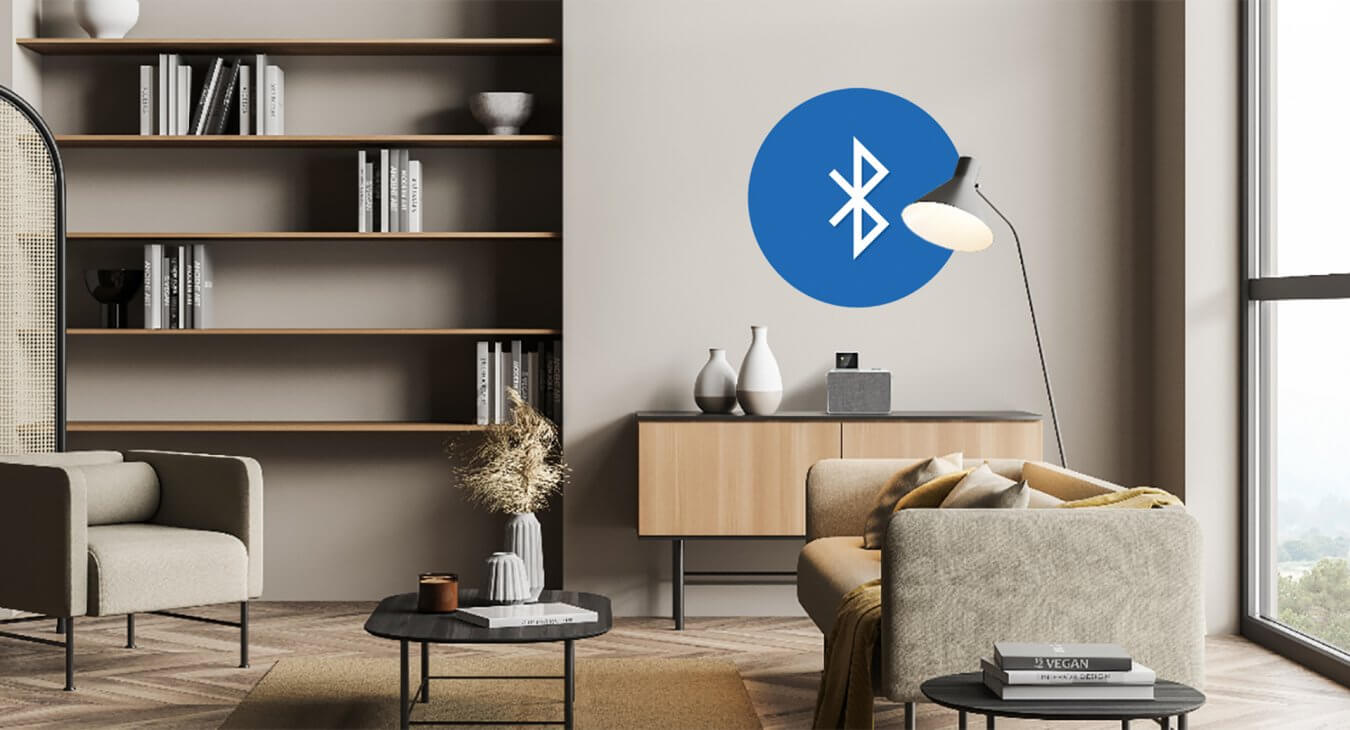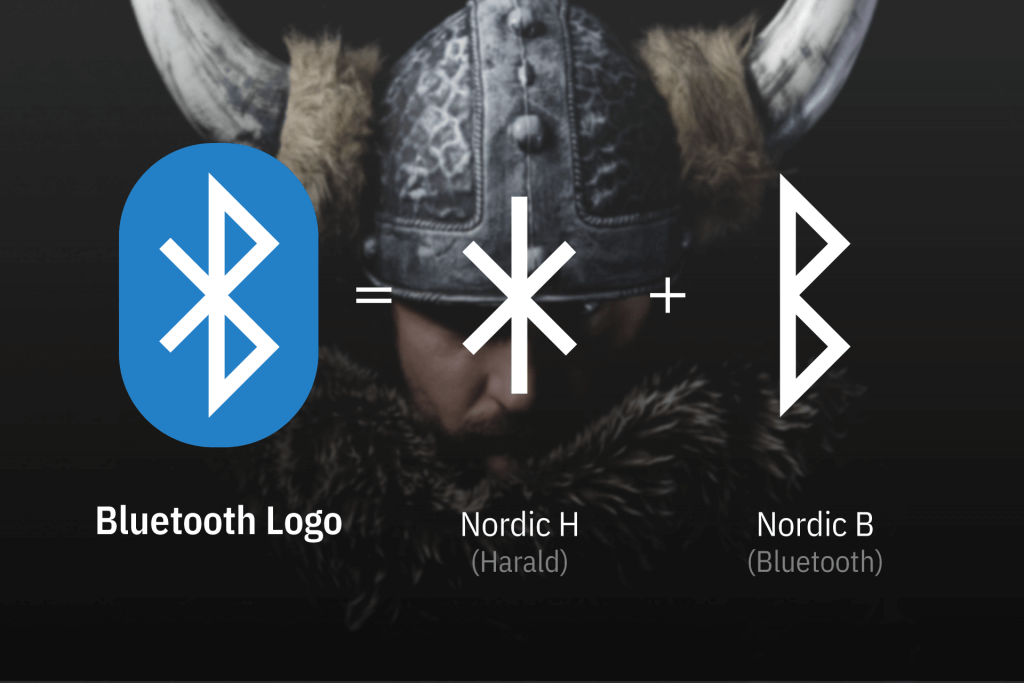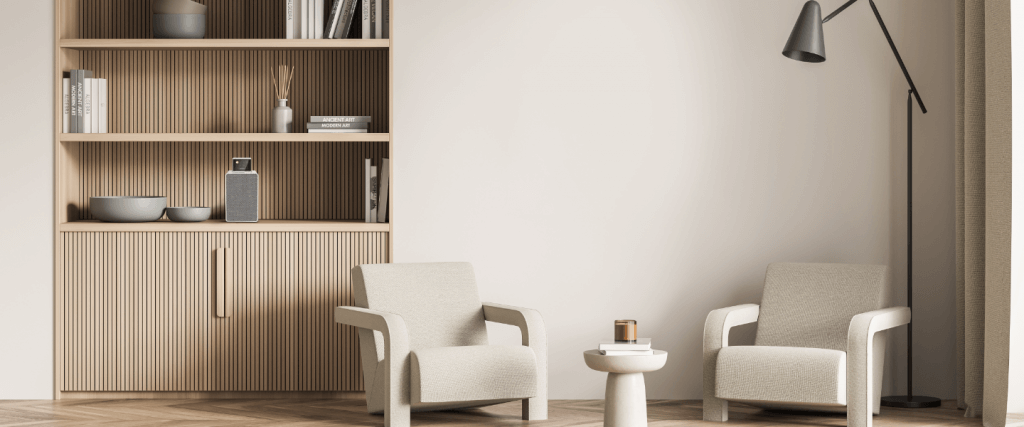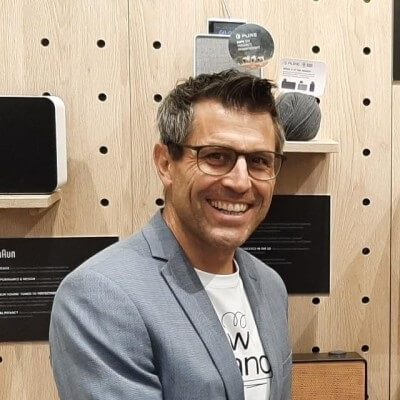Bluetooth – here to stay!
Whether you are using your smartphone, headphones, car radio, loudspeakers or Hi-Fi system – you probably won’t be using it without a certain technology that’s become ubiquitous in today’s world: Bluetooth. Bluetooth is an established standard for cable-free listening to audio content or for communicating via telephone systems using headsets. There are even so-called Bluetooth radios like the Evoke H3 or the Evoke Home Special Edition by Pure.
While back in the day cables were necessary in order to establish a connection, and devices required integrated audio players and loudspeakers, these days there is a higher degree of freedom thanks to Bluetooth. It is, probably most prominently, also used to operate input devices such as cordless computer mice or keyboards.
And while Bluetooth might be most commonly used in connection with smartphones and gaming, it is also being put to industrial use, so to speak, for instance as part of housing technology. Beyond that, it finds its use in any area where IoT (Internet of Things) is slowly but surely turning into an established standard itself, enabling devices, machines and robots to communicate with one another by means of Bluetooth. The medical industry is yet another example. Here, Bluetooth is incorporated in orthopaedic prostheses or in sensors for measuring instruments used by patients suffering from diabetes.
The technology’s newest version, Bluetooth 5.2, is expected to bring significant progress for navigation and location devices. It is set to become the new standard for gadgets guiding visitors through museums and exhibitions, while it will also ease navigation at train stations and airports, and offer support to first responders trying to locate missing persons.
In fact, Bluetooth is an absolutely relevant technology, so it is not astounding that there are uncounted scientists working on constantly developing the standard, improving its quality and finding new ways to utilize it. In this article, we will not only take a closer look at the technology’s roots and the different versions available, but also at where it got its name from.
What exactly is Bluetooth?
Bluetooth is a wireless communications technology that can transmit data – including music, videos and images – over short distances.
The foundations for the development of Bluetooth were laid in the 1990s when the Swedish enterprise Ericsson introduced a project called “Short Link”. The initial goal was to achieve better transmission quality than the one possible with standard radios while also eliminating the potential for interferences. In the late 1990s, the technology was further developed by the so-called “Bluetooth Special Interest Group” (SIG) to finally become the new industry standard for the telecommunications industry.
Most of the interest group’s members involved in the development were Scandinavian companies such as the “Short Link” initiator Ericsson, but also Nokia, a pioneer in the development of mobile phones or the multinational corporation Intel. Even today, individuals as well as organizations can join the SIG on bluetooth.com to play their part in developing the technology further.
Where does the name Bluetooth come from, and who was Harald Bluetooth?
Since the technology was mostly developed in Northern Europe, it was also named after a historic Scandinavian figure. Bluetooth owes its name to a certain Harald Blatand, or Harald Bluetooth, who lived in Denmark from 910 bis 987 and was renowned for his formidable communicative skills. By uniting the different Danish tribes, he laid the foundations for the Kingdom of Denmark, before he went on to introduce a treaty between Denmark, Sweden and Norway, thus stabilising the entire region.
In reference to Harald Blatand, the Bluetooth logo is based on the two Nordic runes for H and B.
What are the advantages of Bluetooth?
As already mentioned, one of the goals of Bluetooth was to get rid of interferences. Interferences are the result of overlapping signals that can lead to the malfunction of wireless systems, for instance caused by the presence of different radio waves in a room or by electrical and magnetic fields emitted by mobile phones, microwaves or computers.
Bluetooth uses specifically coded radio waves to send and receive data between two paired devices. The technology enables the transmission of audio- and video streams as well as images by sharing them on compatible devices. It is commonly used to transmit music from a smartphone to a car radio but even outside of automobiles it can be used to play music from a mobile phone or other Bluetooth-enabled terminal device on a radio. Bluetooth-enabled radios by Pure additionally have the ability to receive radio programmes – either the classic, analog, way or digitally.
One of the main benefits of Bluetooth is the fact that it is cable-free, thus putting an end to the jumble of cables that would usually ensue. Also, since it doesn’t require cables, there is no more need for adapters and sockets. And since the already mentioned SIG (Bluetooth Special Interest Group) keeps developing, it seems to be a given that “Bluetooth has come to stay.”
What is Bluetooth pairing?
The process of pairing interconnects two Bluetooth-enabled devices, for instance a smartphone and Bluetooth-enabled headphones or a Bluetooth-enabled radio. In order to do so, both gadgets need to have their Bluetooth feature activated and be in close proximity to each other – ideally in the same room.
Both the sending and receiving device can be found under their respective device names. Closed pairing can seem somewhat tedious at times, however, it serves to guarantee the safe and uninterrupted transmission of data via Bluetooth connection.
What is the most current Bluetooth version?
The latest version is Bluetooth 5.2 and it targets the trend of wireless IoT technologies. The “Internet of Things” describes the smart connection of devices. An IoT-enabled washing machine for instance is able to notify its user when it’s about to run out of washing powder, or, even better, order replenishment from the manufacturer itself.
| Bluetooth version | Launched | Data rate | Relevant updates |
|---|---|---|---|
| Bluetooth 1.0a | July 1999 | 732.2 kbit/s | First official version |
| Bluetooth 1.0b | December 1999 | 732.2 kbit/s | General improvements |
| Bluetooth 1.1 | February 2001 | 732,2 kbit/s | Cleared of connectivity and safety issues; first product version ready for market; encryption; allowing for up to seven simultaneous connections |
| Bluetooth 1.2 | November 2003 | 1 Mbit/s | Downward compatibility with Bluetooth 1.1; less delicate thanks to AFH (Adaptive Frequency Hopping) |
| Bluetooth 2.0 + EDR | November 2004 | 2.1 Mbit/s | Three-times increased data rate thanks to EDR (Enhanced Data Rate); various energy-saving procedures; additional use of NFC (Near Field Communication) when pairing |
| Bluetooth 2.1 + EDR | August 2007 | 2.1 Mbit/s | Automatic connection without PIN thanks to Secure Simple Pairing |
| Bluetooth 3.0 + HS | April 2009 | 24 Mbit/s | Additional high-speed channel (HS) on Wi-Fi-basis and UBB (Ultra Broadband) |
| Bluetooth 4.0 LE ( Bluetooth SMART) | December 2009 | 24 Mbit/s | Low Energy (LE) protocol stack for various energy-saving procedures (e.g. GATT profile) for small devices; improved error correction; 128-bit encryption |
| Bluetooth 4.1 | December 2013 | 25 Mbit/s | No more need for intermediaries for compact devices; Pv6 |
| Bluetooth 4.2 | December 2014 | 25 Mbit/s | General improvements |
| Bluetooth 5 | December 2016 | 50 Mbit/s | Clearly improved range and data rate |
| Bluetooth 5.1 | December 2019 | 50 Mbit/s | Ability to navigate indoors, find keys and provide information on pieces of art in museums |
| Bluetooth 5.2 | December 2020 | 50 Mbit/s | Low-energy audio for hearing aids, infotainment and gaming headsets, IoT-enabled devices can communicate directly without the need for an app |
Advantages of the most current Bluetooth version 5.2
While version 5.1 offered an important update for all Corona notification apps by allowing the measurement and documentation of the distance between devices, version 5.2 focuses on “low energy audio”. This means it is able to transmit a signal to an unlimited number of recipients, making it useful for a number of purposes.
The intention behind the update was to enable the operation of certain services without the need for active pairing, apps or any additional software. Amongst others, the following procedures and operations are made possible thanks to an increased reach as well as improved localisation abilities:
- Guided navigation in public buildings such as train stations, congress halls or airports
- Documentation of stock levels for industrial and manufacturing purposes
- Localisation of missing persons by rescue services
- Utilisation in Smart City infrastructures for visually impaired citizens
Additionally, the most current version is a real milestone in regard to the development of IoT, as it allows devices to share data without the need for an app or software device.
What is Bluetooth being used for?
Bluetooth is a radio standard that can be found in numerous applications, from speakerphones in the car to Bluetooth-headsets, from sports watches that need to be connected to apps on a smartphone to the simple transmission of audio services and apps such as Apple Music, Amazon Music or Spotify to Bluetooth-loudspeakers or Bluetooth-enabled radios. In addition, it allows for the transmission of screen content to Smart TVs.
Apart from countless mobile communication applications, Bluetooth is being used in gaming devices, home technology, general industrial applications and medical devices.
Bluetooth as a standard for PCs and laptops
- Connection to mobile phones for data exchange (Skype)
- Headsets for VoIP and music playback
- Wireless use of input devices like keyboard, mouse or touchpad
- Wireless transmission of data bundles
Examples for Bluetooth used in communications
- Automobile radios and combined hands-free sets for smartphones
- Headsets for smartphones
- Portable loudspeakers to be paired with smartphones
Bluetooth in gaming and lifestyle devices
- Controller for gaming consoles like Nintendo Wii or Nintendo Switch, Playstation or Xbox
- Dolls, toy robots or toy vehicles controlled and steered via smartphone
- Drones
Bluetooth applications in housing technology
- Alarm systems
- Cordless infrared heating elements
- Cordless light control
- Locking technology for doors and locks
Industrial use of Bluetooth
Since Bluetooth offers a high degree of reliability in terms of signal quality and data security, it is ideal for industrial use, for instance in the
- technical communication in automatisation and mechatronics
- technical communication in manufacturing plants
- recording of processes
Bluetooth in medical engineering
- Control and coordination of arm- and leg prostheses in orthopaedics
- Data exchange via transponder in high-end hearing aids
- Control of insulin pumps via app
- Mobile ECG functionalities for patients suffering from cardiovascular diseases
- Recording of pulse, oxygen saturation and sleep in smartwatches
What’s the reach of Bluetooth?
The range of Bluetooth is said to reach from 10 to 100 metres and it is defined in classes. In closed rooms, Bluetooth-enabled Class 1 devices have a reach of up to 100 metres while Bluetooth-enabled Class 2 devices have a signal reach of up to 10 metres and Class 3 devices only reach up to 1 metre.
Used outdoors, Class 1 devices have a reach of up to 200 metres, while Class 2 devices have a reach of up to 50 metres and Class 3 devices of 3 to 10 metres.
| Class | Max. transmission capacity | Max. reach (indoors) | Max. reach (outdoors) | Areas of application (examples) |
|---|---|---|---|---|
| Class 1 | 100 mW | 100 m | 200 m | Computers, notebooks |
| Class 2 | 2.5 mW | 10 m | 50 m | Bluetooth adapters, computers, notebooks |
| Class 3 | 1 mW | 1 m | 10 m | mobile devices |
Can the reach of Bluetooth be extended?
With the use of a so-called repeater, which serves as a signal amplifier, the reach of Bluetooth can be extended and the signal can be amplified. However, that being said, Bluetooth repeaters are only recommended for use with Class 1 and Class 2 devices since Class 3 devices with a reach of a mere metre will hardly allow for amplifying their signal. If attempted, the reach could never be extended to meet that of a Class 2 device.
Notebooks that are in need of an improved signal can use a Bluetooth stick in order to get a better Bluetooth signal.
What are the different Bluetooth devices available?
These days, there are a number of different Bluetooth devices, pretty much all of which can connect directly. Smartphones, both Apple iPhones with iOS or Android phones from any manufacturer, would be the type of device most commonly making use of Bluetooth, for instance to connect to different gadgets such as hands-free sets, headphones and external loudspeakers or radios.
Since they combine the advantages of Bluetooth transmission with the option to receive radio programmes in a terrestrial way or online, Bluetooth-enabled radios are an exciting alternative to traditional radios or Hi-Fi systems. Products range from simple beginner’s models like Pure’s Siesta Charge to systems that pull out all the stops.
Another type of Bluetooth-enabled device that is commonly used are cordless computer mice or keyboards for PCs and laptops, irrespective of whether they run on an Apple or Microsystem operating system.
What are the disadvantages of Bluetooth?
Apart from all the obvious benefits already mentioned, such as easy connectivity and user-friendly compatibility with a wide range of devices, Bluetooth also has certain disadvantages that need to be considered when using the technology:
- Reach: The reach of Bluetooth is limited and depends on different factors, like interferences and surroundings. Should the connected devices be too far apart, there might be connectivity issues or interruptions/disruptions.
- Speed: Bluetooth has a slower transmission speed than other wireless technologies, like, for example, Wi-Fi. This can be a problem, especially when transferring large amounts of data.
- Interferences: Bluetooth can be disturbed by other electronic devices such as microwaves, Wi-Fi routers or any other Bluetooth-enabled gadgets, which may lead to connectivity issues.
- Power consumption: Bluetooth requires power and it can quickly drain a device’s battery, especially if activated over longer periods of time. In other words, the battery’s regular runtime will be shortened if Bluetooth is activated.
FAQs about Bluetooth
How do I connect devices using Bluetooth?
The connection of Bluetooth devices is simple and can be achieved by following several steps:
- Activate Bluetooth on the devices you want to connect. On most smartphones, Bluetooth can be found and activated under general settings.
- Once activated, use one of the Bluetooth-enabled devices to scan for other devices that have been Bluetooth-activated. They are usually listed under device name, manufacturer name or – in case of smartphones – any other name given by the owner.
- Choose the device you want to connect to from the list of available devices and accept the connection on both devices. You may be required to enter a 4-digit code to do so.
Once the devices have been successfully paired, they should be able to transmit data and audio signals.
What is Bluetooth used for?
Bluetooth is an international radio standard for the wireless connection of devices in order to transmit data including audio signals and other information required in different industries.
When do I need to activate Bluetooth?
Bluetooth should be activated in order to pair one device with another. The procedure is called Bluetooth pairing and it provides an encrypted connection between the sending and receiving devices.
How does Bluetooth work?
Bluetooth is a wireless technology that allows different devices to communicate with each other. It is used to connect devices like smartphones, loudspeakers or headphones. Bluetooth transmits data and audio signals between those devices without the need for a cable.
What are the disadvantages of Bluetooth?
Bluetooth only has a limited range. It requires a lot of power and thus drains batteries quickly. Furthermore, Bluetooth has its limits when transferring large amounts of data.
Can Bluetooth be updated?
Devices that have no Bluetooth feature can be updated relatively easily and cheaply. All that’s needed is an adapter that can either receive or send Bluetooth signals, if not both. The most common Bluetooth adapters are 3.5-inch adapters to be used with headphones as well as plug adapters. Many wireless keyboards and mice come with their own USB adapters.
Is Bluetooth harmful?
The electromagnetic radiation of Bluetooth is very low and thus not classified as harmful.







